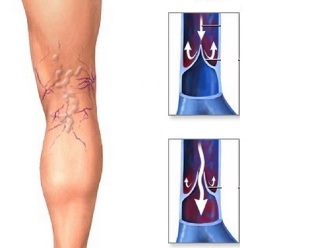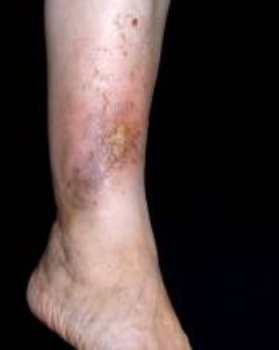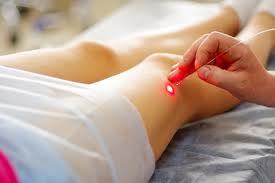
Varicose veins (varices) is one of the most widespread and ancient diseases of the circulatory System, the discovered, from the time of ancient Egypt. With the Egyptian Papyri and the archaeological excavations, the mummy was found with signs of varicose veins. This disease interested and famous ancient doctors: Hippocrates, Galen, Avicenna, and later Trojanow, Trendelenburg. Ido this disease has not lost its importance in modern medicine. The Definition of "varicose" comes from the Latin word "varix," which means "extension", so the disease has the title of "varicose veins". This disease is characterized by the enlargement and the increase in the length of the peripheral veins in the Form of a serpentine tortuosity (deformations), as well as violation of the outflow of blood in him, from the defectiveness of the device and weakening of the wall. The disease most often the veins of the lower extremities are affected, since the main burden of the outflow of the blood (large volume), therefore this section is preferred. Varicose veins occurs in about 17 - 25% of the population. At a young age the disease occurs, as well as in boys than in girls. At the ripe old age women 2 suffer 3 times more often than men due to the hormonal changes of the female body (Menstruation, pregnancy, menopause).
Causes and risk factors for the development of varicose veins
The exact cause of the disease is not known, we only know that under the influence of certain factors, a weakening of valves, pressure rise and loss of elasticity of the walls of the superficial and connecting veins develops. Risk factors:
- Genetic predisposition: the transfer of varicose veins be inherited caused by a Mutation of the gene responsible for the structure of the vessel wall, as a result of his Mutation, children are born with a congenital weakness of the connective or muscle tissue of the vascular wall, either the disadvantage of the valves (the disadvantage of your lot), and as a result of the weakness of the vessel wall and increasing the pressure in the veins occurs.
- Hormonal changes (pregnancy, menopause): in pregnancy the hormonal composition of the body changes (increase level, decrease progesterone and estrogen) that influence the formation of blood clotting factors (increase), decrease in the Tonus of the venous wall (in consequence of the destruction of collagen and elastic fibers of the vessel wall) all of this leads to the formation of blood clots and blockage of blood vessels and their Deformation.
- Obesity : obesity leads to a sedentary life-style, in consequence of which there is a slowing of blood circulation, Plus the excess fat increases the intra-abdominal pressure, against the outflow of blood through the veins, in consequence of a congestion in the veins and the possible development of the disease develops.
- Diabetes mellitus :chronic elevated blood sugar levels damaging vessels in the course of time, the walls of the blood clots is a favorable medium for the development of blood.
- Alcohol abuse : excessive alcohol consumption leads to dehydration and thickening of the blood, in consequence of blood clots, which clog the veins and interfere with the outflow of blood.
- Weight lifting (Mover),go for long, long years of or related work (the seller, conductor): associated with a decrease in the muscle tone, increasing intra-abdominal pressure and, as a result of a slowing down and obstruction of blood flow to the heart and to the development of Stagnation in the lower extremities.
- Congenital disorders of blood coagulation: congenital hypercoagulability (excessive production factors suppressing the blood) leads to the formation of thrombi and the violation of the promotion of blood through the vessels.
- Poor nutrition: a lack of certain vitamins in the diet (Vit.C, E, P, plant fibers play a role in the strengthening of the vascular wall and improving blood circulation).
- The wearing of tight underwear: his constant wearing will lead to a mechanical compression of the veins, leading to difficulties in venous return from the lower extremities.
- Chronic constipation : frequent increase of the intra-abdominal pressure (during exercise) leads to difficulty of outflow of blood from the lower extremities.
- Frequent walking on high heels: the lack of movement of the muscles of the lower leg and the development of Stagnation.
- To lead the hot season of the year: frequent thirst, dehydration of the body, the thickening of the blood, and the formation of blood is done clots.
- The accompanying cardiovascular disease or renal disease: impaired outflow of venous blood (insufficiency of the heart valves, congenital malformations).
- An overdose of drugs, the vessels of the blood clotting: the risk of blood clots and blockage of blood.
- Surgical interventions:the loss of a certain amount of blood, no comfortable Position on the operating table (compression of certain blood vessels) that lead to clots risk of blood.

Complications of varicose veins
- The formation of blood clots, the Stagnation of the blood in the veins;
- the detachment of the Thrombus and blockage of the vessel coincides with its diameter;
- Thrombophlebitis (due to the formation of thrombi in the Lumen of the vein occurs, the inflammation of its walls);
- Pulmonary embolism (detached Thrombus overcurrent blood in the pulmonary artery, which is involved in the in the small circle of blood circulation. If the diameter of the Thrombus corresponds to a trunk diameter of this artery, it can cause sudden death. If the clot is smaller in diameter, then it's on to the branches of the pulmonary artery, causing pulmonary infarction or swelling).
- Wounds or eczema of the legs as a result of malnutrition (impaired blood circulation leads to a lack of oxygen supply in the tissue, which is the most important nutrition of the tissues of the organism);
- Swelling of the different parts of the body in consequence of the Stagnation in the veins (they are not soft, ductile, bluish color, your education is dependent on the time of day, often in the area of the affected land);
- Dermatitis (inflammation of the skin in the affected area) at the expense of the supply of this land;
- Discoloration of the skin in the area of the affected area;
- the seal of the subcutaneous adipose tissue in the area of the affected area due to swelling.
The diagnosis of varicose veins
- The flagellum (functional) tests (determination of the patency of the veins and the Status of your valves): Troyanov - Trendelenburg,Pratt, Sheynis, Delbe-Perthes, and others. One of the most common experimental Troyanov - Trendelenburg with the patient while in a horizontal Position, raise the leg to 45 0, the doctor makes the stroking from the foot to the top (which will be cleared of the superficial veins), then the cable harness on the upper side of the thighs and ask the patient to stand up, in the standard filling of the veins of the lower leg should be longer than 15 seconds;
- Duplex ultrasound investigation of the veins (ultrasound angioscanning) allows the most informative method to evaluate the blood flow in the vessel and the vessel itself;
- Dopplerhophy method, the estimated blood flow in this vessel;
- Venography - introduction of contrast medium intravenously and the study of x-ray images;
- Phleboscintigraphy - the intravenous injection of the radiopharmaceutical and monitoring on a special device.
Treatment of varicose veins
Conservative Treatment

- Traditional methods of treatment (as an adjunct to medical treatment): wearing kompressionnogo Jersey (stockings); special movement (swimming, Cycling, skiing, feet above the head to about 20 0 in terms of beds, special gymnastics ("Cycling" - lying on your back and breathe evenly, and imagine that you in the pedal wheel, and alternately bending and stretching of the foot in the ankle joint to the front and rear) for the improvement of outflow of blood, but not only in difficult cases); Change of showers (under running water to their feet, gradually reducing the water temperature to cold); foot baths (not hot) broth from the bark of oak, chestnut, chamomile, St. John's wort; rubbing alcohol tincture from the flowers of white acacia, leaves of Kalanchoe, Apple cider vinegar; leech treatment for Thrombophlebitis.
- Daily routine: in the morning, slowly getting up from the bed (e.g., within 5-10 minutes), during sleep place a pillow under the heel so as to lift the legs about 15-20 0 opposite the bed, to the foot should be quiet, not to sit crossed leg to leg, bandaged legs, elastic bandage from foot up to the upper part of the thigh, the wearing of medical compression stockings, well-balanced diet, you should avoid any strenuous movements, and any substances or factors contributing to the thickening of the blood, with the exception of Smoking, The prevention of constipation.
- Nutrition : the body requires food that contain vitamins strengthen the walls of blood vessels and improve blood circulation: Vitamin C (included with the citruses, tomatoes, rose hips, and others), Vitamin E (legumes, liver, egg yolk, chives), Vitamin P (Grapefruit, walnut, black currant), bioflavonoids (dark cherries, sour cherries), copper (seafood). A sufficient daily amount of liquid of at least 1.5 liters. Limited in the use of alcoholic drinks, coffee, marinades, smoked meat.
Surgical Treatment

Varicose vein surgery:indications for the removal of the veins: extensive varicose veins, subcutaneous veins pathologically expanded, trophic disorders of the skin, not on a conservative treatment, acute Thrombophlebitis, varicose saphenous veins, through a violation of the General condition (severe tiredness, swelling of the legs) of the patient. Contraindications for the removal of the veins: coronary heart disease, severe infectious processes, age of the patient, pregnancy in 2. and 3 Trimester, inflammation on the legs (erysipelas, pyoderma, eczema). The advantages of the surgical treatment: the only possibility of treatment in advanced cases, the only radical method for the correction of the deep venous valves. Disadvantages of surgical treatment: traumatic (flaw), which requires anesthesia, you need to. a couple of days in a hospital under the supervision of the surgeon Laser therapy (endovascular microtermocoagulation) :indication: the combination of varicose veins with the following diseases: diseases of the circulatory System (coronary heart disease, hypertension), diseases of the peripheral blood vessels (Phlebitis, Thrombophlebitis), respiratory diseases (Asthma, Bronchitis, pleurisy), with diseases of the digestive system (cholecystitis, gastric ulcer and duodenal ulcer), diseases of the nervous system (skull-brain Trauma, CNS), diseases of the urogenital tract (Pyelonephritis, Endometritis, salpingitis), with skin diseases (Dermatitis, Neurodermatitis), peritonitis, boils. Contraindications: people with oncological diseases, the disease of the liver, the kidneys and the heart in the Phase of decompensation, cerebral sclerosis, pregnancy. Advantages: allows you to get rid of, vascular pattern, quick procedure (about 15-20), you do not desire to hurt the hospital stay, safe and painless, vascular tissue and the surrounding tissue. Cons: not available everywhere method, a costly method, in the removal of larger vessels possible thermal damage of tissue, the possible formation of scarring and depigmentation (whitening) of the skin in areas of exposure. The radio-frequency coagulation (Ablation) of varicose veins: the statements: the warikosnaja disease with the defeat of the tribe of the great and small saphenous veins, trophic ulcers, in consequence of varicose veins. Contraindications: acute thrombosis subcutaneous veins, the inability to walk, pregnancy, mental disorders. Advantages: without any cosmetic defects, painless, requires no hospitalization, breaks the ability to work. Cons: the only drawback is the price of the procedure. Sclerotherapy: indications: fine varicose veins, large varicose veins with the use of the Duplex dopplerography, varicose veins in the early stages (in the case of damage, only superficial veins. Contraindications: pregnancy and lactation, Allergy to sclerosus, deep vein thrombosis, Pyo-inflammatory diseases of the legs. Advantages: lower cost compared to surgery, fast time of the Regeneration, does not require a stay in the hospital (you can go home immediately), the best possible cosmetic result. Cons:possible penetration in the deep veins sclerosus, a drop in the efficiency due to the mixing sclerosus with blood, in advanced cases is ineffective.




































